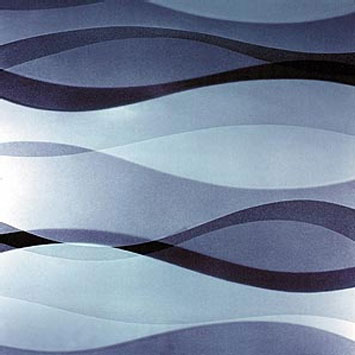kiln formed glass, offers an exciting range of possibilities to create and capture fluid textures, patterns and optical effects, by using heat to form and manipulate float glass over refractory moulds. whether bespoke or standard patterns, kiln formed glass gives a unique beauty, subtlety and tactile quality.
kiln formed glass is enormously versatile enabling it to be used in almost any application either decorative or superstructural for both internal or external applications.
 Surface Decoration Surface decoration involves the more traditional forms of; sand blasting, acid etching, gliding and screen printing. sand blasting is the most versatile form of etching glass. effects range from simple frosting, which can incorperate logos , patterns and graphics to more complex deep carved, 3D work. subtle effects can be achieved by using hard and soft lines, semi-tones, layering and a variety of textures.  Laminated Glass Veneer - Combining the rich natural aesthetic qualities of wood with the practical structural and aesthetic qualities of glass we can offer architects and designers a wealth of possibilities for cladding and screen buildings and for use internally for partitions, wall finishes and flooring. various bespoke designs and finishes can be combined with veneer such as etching to create matt surfaces veneers cut and shaped to create patterns and designs. wood veneers can only be viewed from one side with translucent finish to back. alternatively 2 layers of veneers can be used back to back and laminated between glass if glass is required to be viewed from both sides. Coloured Laminate - coloured PVB interlayer allow for a rich palette of colour permutations, which range from subtle transparent and translucent colours to opaque that can be used for a wide variety of applications including; screens, partitions and cladding. Interlayer's come in a range of 14 colours, which can be combined to give a palette of over 800 colours. Metal Mesh - Metal meshes from finely woven gauzes to thickly braided weaves and decoratively etched metal foils, offer an innovative range of structural and design opportunities. These materials allow the transparency, rigidity and structural qualities of glass to be combined with the decorative and aesthetic qualities of the metal weaves and meshes. Fabric - Laminating allow fragile textiles to be captured within layers of glass to create structural panels. offering architects and designers a wealth of possibilities to combine and encapsulate a diverse range of materials, which can be applied externally to clad and screen buildings as well as internally for partitions, features and furniture. Surface Decoration - surface decoration involves the more traditional forms of; sandblasting, acid etching, gliding and screen printing. sand blasting is the most versatile form of etching glass. effects range from simple frosting which can incorporate etched logos, patterns and graphics to more complex deep carved, 3D work. subtle effects can be achieved using hard and soft lines, semi-tones, layering and a variety of textures. Digital Printing - Digitally printed laminates allow virtually any digital image whether pattern or photographic , solid colour, continuous tone or or fade to be accurately reproduced and then encapsulated within a laminated structural safety glass. this gives designers and architects a wealth of creative possibilities from individual features, screens to the creation of entire façades for both interior and exterior application. Back Painting - f/coat is a specialised glass colour coating system, providing clients with a rich palette of colours from an extensive range, it has excellent adhesion and performing characteristics. whether you choose transparent, opaque, metallic, lustre or frosted f/coat offers an unlimited design potential, combining the natural beauty and practicality of glass with a colour of your choice. f/coat standard range gives you a comprehensive choice of 20 colours. | |
No comments:
Post a Comment